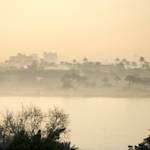Desiccation of the Aral Sea
1960s - present • Kazakhstan, Uzbekistan
"The lake was used for fishing and we could see sailing and fishing boats. Now, we still can see them, but they are stuck in the sands." —Aksoltan Ataeva, Turkmenistan's Permanent Representative to the United Nations The Aral Sea was once the world's fourth largest lake, which supplied a booming fish industry and critical water source to local settlements in Kazakhstan and Uzbekistan. The Soviet Union began diverting large amounts of water for irrigation in the 1930s, as part of its efforts to transform the region into a cotton exporter. By the 1960s, the lake began to rapidly and steadily shrink. Today it covers around 10% of its historic size. Its disappearance is considered a total ecosystem collapse, and has been called "one of the planet's worst environmental disasters" by the United Nations.
Beatrice Grabish, "Dry Tears of the Aral," UN Chronicle, no. 1, 1999. Philip P. Micklin, "The Aral Sea Crisis," in ed. Jacques C.J. Nihoul, Philip P. Micklin, and Peter O. Zavialov, Dying and Dead Seas Climatic Versus Anthropic Causes (Springer: 2004), 99.
Image: Ecpirolli, CC BY 4.0 via Wikimedia Commons


Learn about Maya Lin’s fifth and final memorial: a multi-platform science based artwork that presents an ecological history of our world - past, present, and future.

Discover ecological histories and stories of former abundance, loss, and recovery on the map of memory.

Learn how we can reduce our emissions and protect and restore species and habitats – around the world.

See how art can help us rethink the problems we face, and give us hope that each one of us can make a difference.

Help make a global memorial something personal and close to home. Share your stories of the natural world.


